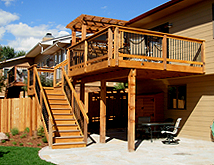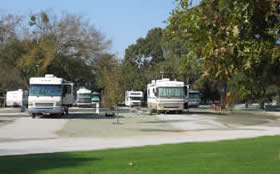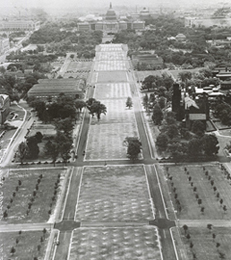Building a Deck – What is the Best Decking Material?
If you’re in the market to replace your existing deck or want to build a new one, you will want to know what products are available and what your contractor can do with them.
A beautiful deck starts with careful planning and design. The best looking deck often reflects some architectural elements from the house and uses them in the deck. If you have multiple decks on your home consider using matching handrails and decking material for uniformity. Consult with your builder or designer for the many options available today.
 Overall deck costs tend to range from $25-$35 per square foot and cost varies due to height and complexity of construction. The cheapest decking material on the market is probably pressure treated pine the most expensive include exotic hardwood species and top-end coated composite decking. Here is a quick run-down on some of the decking materials available:
Overall deck costs tend to range from $25-$35 per square foot and cost varies due to height and complexity of construction. The cheapest decking material on the market is probably pressure treated pine the most expensive include exotic hardwood species and top-end coated composite decking. Here is a quick run-down on some of the decking materials available:
Decking Materials:
Redwood – soft wood prone to damage from hail, includes the removal of old growth forests that take centuries to recover. Redwood takes hundreds of years to mature and therefore is not a sustainable wood source. Redwood coast around $3-4 per linear foot depending upon the quality ordered.
IPE – Brazilian rainforest lumber that is very dense (hard) and durable. It has a dark color and requires pre-drilling for fasteners. I do not know of any that is sustainably grown / harvested lumber. IPE costs around $4 per linear foot depending on thickness used.
Tigerwood – Brazillian or African rainforest lumber that is very dense (hard) and durable. It has a light dark color variation (tiger striping) and requires pre-drilling for fasteners. I do not know of any that is sustainably grown / harvested lumber. Tigerwood costs around $4 per linear foot depending on thickness used.
Cedar – Soft wood prone to damage from hail, be sure to specify better grades of wood and tight knot or better, can come rough sawn for beams or trimmers and works well for handrails. Tight knot cedar cost around $2 per linear foot and the price almost doubles for clear cedar.
Pressure treated pine: Typically made from southern yellow pine which is pressure treated forcing chemicals into the wood that resist rotting and insect damage. The treatments usually contain copper compounds & other chemicals that are highly corrosive to metals, so extra zinc treatment to galvanized fasteners is recommended to avoid rusting. Older treated wood, produced prior to 2004, often contain arsenic & chromium which can be easily released if burned. It is important to allow the wood to dry out prior to staining or sealing. Pressure treated wood is prone to warping, splitting and twisting and these qualities seem to be exacerbated in dry climates. I believe that staining & sealing these woods can help their look and performance. P.T. pine should be either screwed in place nailed with 16d ring shank nails all fasteners should be hot dipped galvanized.
Composite:
Should you use real wood or composite decking? In the last ten years composite decking materials (plastic/ wood particles glued together) have taken hold of the market and are used on over half the decks being built. Several companies use 90% recycled plastics in their products which will help reduce waste. However, I do not know of any composites that are recyclable when they need replacement. If decking could be continually recycled it would truly be a sustainable product, but no companies, to my knowledge, have produced such a product. All composite decking materials rely on a type of adhesive or glue that bond all of the plastic and wood particles together. These adhesives can be any number of polymers(resin) some which can cause environmental concern if released into the environment especially if burned. The life span of composite decking is similar to a wood deck that is maintained, around 25 years. Eventually all decking materials will end up in a landfill.
There are around ten different companies producing composite deck materials in the U.S. with Trex being one of the first and widely know. These materials include decking and handrail systems and most companies offer different product lines that vary in color and consistency. One California company even offers a bamboo composite BamDeck which uses 30% bamboo and 70% recycled plastic.
The cost of composite decking varies from $2-$4 per linear foot of decking board. Common sizes for composite decking boards are 12’, 16’, 18’ and some 24’ lengths are available from certain manufacturers. Try to design your deck so that no butt joints are required. Composite boards require spacing butt joints from 1/8”-1/4” for board expansion which can be unsightly.
THE GOOD
- Composite decking does not require as much maintenance as natural wood products.
- Does not splinter or split.
- Have built in slip resistance.
- Are consistent in color, shape, and texture.
- Grooved boards can utilize hidden fastener systems which are attractive.
- Boards can be heated and bent into circular patterns.
- Boards are often made with recycled plastic materials up to 90%, which make it more sustainable.
THE BAD
- Boards without a pvc treatment are prone to staining from many different sources. PVC treatments usually cost around $1 more per linear foot of board.
- Material holds heat and can reach temperatures that will burn bare feet in the summer.
- Material is not structural and typically requires a maximum joist spacing of 16 inches, which also limits what can be done with handrails.
- Material shrinks and swells more that wood which requires spacing at butt joints if used.
- Material requires pre-drilling in many circumstances for fasteners.
- Catastrophic failure, rapid deterioration is possible and almost all manufacturers have had to warranty their product for this reason at one time.
- Material is not recyclable.
- Polymers used to glue product together can be harmful if released into the environment, i.e. burning.
People often ask me what is the best composite to use and to be honest I don’t know. The reason for this is that almost all of the companies making composite materials have produced materials that have failed and needed to be replaced.
In 2009 Louisiana Pacific recalled around 48 million linear foot of decking that was sold under three different trade names (WeatherBest®, ABTCo., and Veranda®). Many other companies have had warranty claims for products that are less than five years old. When composite decking fails you will often notice that the color comes off like chalk when you rub it with a finger.
Once composite decking boards start to fail, they can simply start to rot or you may notice flaking, splits, bubbling or other abnormalities. Boards can also break between joists in extreme failures causing injury. Warranties vary from company to company, but in general you can expect a limited 20 year warranty. One thing to note is that the manufacturer’s warranty will only cover material replacement, not labor to remove the old boards and replace them, which can be a substantial cost. Therefore, do your homework and make an informed decision based on a company’s track record.
Some things you should consider if you are planning to use composite decking:
- Texture (slip resistance) especially in frost prone areas.
- Color – try to compliment your homes color. Most composite deck materials fade 30% in the first year and then stabilize. Some even change color so look at samples that have been weathered when possible.
- Cost – almost everyone is on a budget so pick the best material you can afford.
- Warranty – since there have been failures in the past research the company’s products that you are considering and find out their track record and read the fine print on warranties.
- Maintenance – consult manufacturer’s suggestions but most can be cleaned with mild soaps and water.
There are a lot of things to consider when it comes time to build or replace a deck. A new deck can cost as much as a new car so take the time to weigh your options and hire a competent builder. I suggest that you not only talk with a builder’s past client but also take the time to see one of their completed projects.
No decking is completely environmentally friendly or sustainable. In general, many of the natural wood decking products available are from hardwoods or slow growing softwoods which make them less sustainable. Pressure treated southern yellow pine is a faster growing, more sustainable wood product but it utilizes chemicals for rot and insect resistance. If the composite decking industry can develop a product that is recyclable and will consistently perform it will climb to the top of the sustainability chart and my “A” list.
This is a guest post by Bruce Kehr. The owner of Sunlit Builders, LLC, Bruce is one of the top deck builders in Colorado. You can reach Bruce via email at [email protected].
 water supplies and delivery systems, causing many water providers to provide great incentives to reduce water use. Homeowner’s, businesses, and HOA’s are also looking for ways to trim their budgets and increase their long-term sustainability.
water supplies and delivery systems, causing many water providers to provide great incentives to reduce water use. Homeowner’s, businesses, and HOA’s are also looking for ways to trim their budgets and increase their long-term sustainability.
 This is a guest post by Bud Surles. The owner of
This is a guest post by Bud Surles. The owner of 